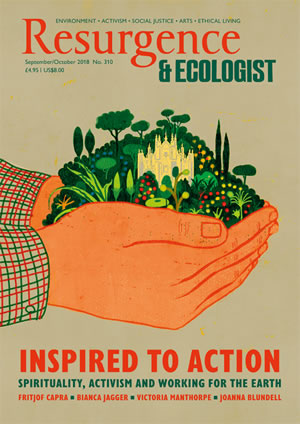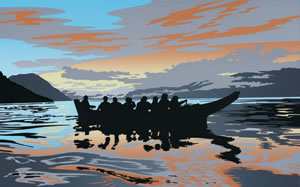“When we walk on this land, we do it slowly, with honour, respect and humility, because we tread on the dust of our ancestors,” says Levi Martin, a Tla-o-qui-aht elder. Towering over the table, he shakes my hand in greeting and wipes the morning dew off the wooden tabletop and bench with the sleeve of his jacket. “That’s why I am a little late.” He winks, sitting down across from me, his face spreading into a mischievous grin.
“Ahhh, such a lovely day,” Levi says, stretching with a sigh, straightening his grey goatee with his hand. Tofino’s summer mornings are foggy, as the cool night breath of Clayoquot Sound clings to the coast of Canada’s western province of British Columbia, sticking to cedars, boats, beaches and outdoor benches. By the afternoon, however, the sun’s rays burn openings in the mist, warming the coastal air and lifting the fog. Our damp bodies welcome the warmth, and we settle on the second-floor patio of the Common Loaf Bake Shop for lunch.
Below the veranda, First Street rolls down to the Tofino docks, where water taxis whisk passengers on the short ride across the Van Nevel Channel to the village of Opitsaht, ‘a gathering place’ in the Nuu-chah-nulth language. Levi’s birthplace, the millennia-old winter village of the Tla-o-qui-aht people, is a collection of bright red, white, and blue single-storey houses lined up along the water’s edge at the foot of the 730-metre-high Wah-nah-jus, or Lone Cone mountain.
A respected healer and spiritual leader, Levi was born in 1945. He grew up immersed in Tla-o-qui-aht culture, language and lore. The youngest of 16 children, he was given the Tla-o-qui-aht name Kaa-mitsk – ‘a fighter and a hunter’ – when he was born. He spent his early days with his family, hunting, gathering, fishing and trapping around the Wah-nah-jus. But, like many other Indigenous children from the communities along the west coast of Vancouver Island – Ahousaht, Opitsaht, Hesquiat, Nootka, and Kyuquot – Levi was sent to the Christie Indian Residential School that was run on Meares Island by the Catholic Church between 1898 and 1983.
Housing around 40 Indigenous children, the residential school, also known as Kakawis, was only a couple of miles from Opitsaht, but it might have been on another continent for Indigenous children like Levi, who were taken away from their families and forced to learn a new culture, language and set of values at the expense of their own.
After leaving the school, Levi drifted around British Columbia. He worked as a carpenter in Vancouver, a logger in Opitsaht, and finally ran a water-taxi business around Clayoquot Sound. He left his business in the mid-1970s in search of ways to reconnect with Tla-o-qui-aht culture, traditional knowledge and practices, and to share them with his people. He began carving, painting, and teaching the Nuu-chah-nulth language. After deciding to follow in the footsteps of his grandfather, a healer, Levi attended a holistic treatment centre for First Nations in the early 1980s and began working with the Nuu-chah-nulth survivors of residential schools. He helped them remember their own history and culture and reclaim their ancestral ways of looking after their Ha’huulthii (homeland). That is when he got his Nuu-chah-nulth name Kaa-muth, ‘the all-knowing one’.
I meet Levi at the end of a global journey I’ve made for a book, The Archipelago of Hope, exploring how the inextricable links between Indigenous cultures and their traditional territories form the foundation for climate change resilience around the world. What I have learnt is that there is no magic pill that would cure the climate change fever consuming our planet. The medicines are as diverse as the peoples and communities using them – from adjusting the seasonal migration routes of reindeer herds to avoid extreme weather events in the Arctic, to burning trees to enrich the forest in Thailand, to keeping the oil in the ground in the Amazon.
The circumstances of each Indigenous community are different – distinct cultures, unique histories, diverse ecosystems, and multiple climate change impacts. Yet their individual predicaments are fundamentally similar – colonial history, displacement, pressure from resource extraction, and limited political power to determine their own future.
To understand how Indigenous communities stay resilient in the face of all the challenges that the ‘civilised’ world continues to throw at them, including climate change, it is essential to go beyond dissecting the specific how-to lessons, and attempt to explore the fundamental principles of how these communities maintain their relationships with the living world around them. To heal the Earth and rebalance our relationship with it, it is not enough to ‘treat’ the symptoms: our medicine must penetrate to the very core of our affliction. This is why, when I meet Levi for lunch, I am seeking some guidance from the ‘all-knowing’ Kaa-muth.
“Over three decades ago, we had lots of violence in our communities – drinking, fighting, even murder,” Levi explains to me. “It felt like our culture was weakening and we were growing more and more disconnected from the land and our ancestors. I decided then to begin my healing journey, to restore myself and help my people. We’ve been on that journey ever since. Along the way, I’ve seen a lot that gives me hope. My people are a lot stronger now. Many have set off on their own healing journeys, reconnecting with the land, our ancestors and our traditions.
“An elder told me once that it may seem that many of our traditions and songs are lost, but we have nothing to worry about. They’re just put away for now, stored in our collective memory, our land. It’s going to be our children, he said, who’ll bring them back. And, over the years, I’ve seen it happen. I’d take our boys and girls out to different parts of our Ha’huulthii and some of them would bring back our forgotten songs, our traditions, our knowledge – whatever gift the Creator would choose to share with them.”
Traditional knowledge bubbles up from the deep spring of ancestral wisdom embedded within the Indigenous peoples’ traditional territories, nourishing the long-term, intimate and sacred relationship between Indigenous peoples and their land, water, air and the cosmos. There is a growing body of evidence in scientific and policy-making communities showing that to maintain resilience in the face of change, we must draw on the best available knowledge, regardless of its epistemological origins – whether it is traditional knowledge rooted in millennia of meticulous on-the-land observations of seasonal animal behaviour, or contemporary scientific methodologies that rely on satellites to remotely capture large-scale changes.
What makes Indigenous communities uniquely valuable in the global quest for climate change solutions is that they are the ‘testing grounds’, the ‘laboratories’, where the traditional practices and understanding of Nature meet modern technology and scientific insights, generating new knowledge critical for developing culturally appropriate and relevant climate change adaptation and mitigation responses. But this process of co-producing knowledge works well only when the rights of Indigenous peoples to make decisions about their territories are acknowledged and respected, as required by the UN Declaration on the Rights of Indigenous Peoples (UNDRIP), which has been endorsed by 148 countries. Recognising the inherent rights of Indigenous peoples to be stewards of their lands and waters is key if their traditional territories are to continue to play an important role in biodiversity conservation and climate regulation.
According to the Rights and Resources Initiative – an NGO working on land and resource rights of Indigenous peoples and local communities – the world’s 370 million Indigenous people make up less than 4% of the world’s population, but represent close to 60% of the world’s linguistic and cultural diversity. Their traditional territories represent more than 20% of the global land area, or between 30% and 50% of the world’s collectively held and managed lands, or commons.
Indigenous peoples’ traditional territories support about 80% of the world’s biological diversity and contain close to a quarter of the carbon stored above ground in the world’s tropical forests (so not including the carbon stored in the soil). But despite all the benefits that Indigenous territories provide to the global community, Indigenous land rights are legally recognised on less than 20% of their traditional areas. The most efficient path towards enhancing climate change resilience at both the local and the global level is to secure and support Indigenous peoples’ rights to their lands and waters, so that they can continue to support the majority of the Earth’s remaining biological and cultural diversity, intact forests, undammed rivers, and ecosystem services.
“There are four sacred, most powerful elements that sustain life and all living things,” Levi concludes. “Fire, water, air, and Mother Earth. Nothing survives without them. But as powerful as these elements are, none of them can support life on their own. Take water away, and nothing in this world could survive. The same is true for the other elements, because to sustain life, all of them must work in concert. And the way they work together is through the spirit element that connects them all. In the same way, all people – Indigenous and settlers – must work together. But we’ve been disconnected from the spirit for so long that we don’t really know how to do it. This must change fast. We must work together and learn from each other to have any hope of dealing with all the challenges we are facing.”
This article is an edited extract from his book The Archipelago of Hope: Wisdom and Resilience from the Edge of Climate Change, recently published in paperback by Pegasus.








